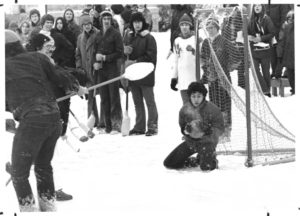
Lawrentians have been coping with Wisconsin winters since classes began in 1849. The Archives has accounts of students having sleigh-rides and making maple candy in the 1850s. In 1928, the athletics department organized a “winter sports carnival” – this featured inter-class competitions in skating, skiing, and tobogganing and was held for just a couple of years. Sometime in the 1940s, a “winter weekend” ski trip to Sturgeon Bay became a mostly annual tradition, lasting into the 1970s. (After our calendar switched from semesters to trimesters in 1962, the phrase “winter weekend” also referred in general to the mid-term break period in February.) On-campus snow sculpture contests also became traditional starting in the 1940s.
But today’s action-packed “Winter Carnival” is directly modeled on one that started in 1976. (There’s an article about it on page 8 of the January 23, 1976 Lawrentian.) This event was held annually until 1979 (then once more in 1981 as “winter menagerie” for some reason.) Student Affairs staff members revived this incarnation of Winter Carnival in 2011 and it has been held every year since then. 2011 was also the first year of the President’s Ball, so this year’s ball will be the 7th annual.
Some of the confusion in recent years about this history likely stems from a blurb in Lawrence’s sesquicentennial publication, “Time and Traditions,” published in brochure format and as a cutting-edge website in 1997. It cites 1933 as the year that “Students painstakingly stack blocks of ice to build a chapel. Ice sculptures become part of Winter Carnival, a tradition that is revived off and on until the present day.” There were ice chapels built on the campus in 1932 and 1933, but these were designed and built by local architects and builders, not students. And there was nothing called “winter carnival” in 1933.
So to sum up: technically, this year would only be the “7th annual” Winter Carnival. But many of its components have roots in older traditions at Lawrence, and that is worth celebrating.